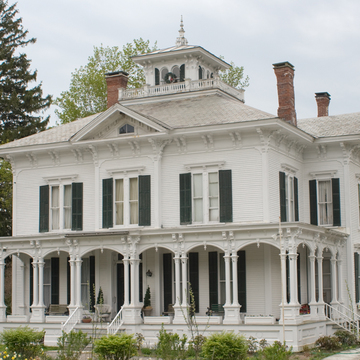This Italianate house is the showiest of a cluster built by the influential Gray family on South Street. Millwright and inventor Albert Gray established the family fortunes, and those of this sleepy village in the midst of the Taconic Range, in the 1840s, based on a patented horsepower treadmill that could be used for everything from threshing to churning butter. A. W. Gray and Sons began producing his machines in 1857 and remained the town's major employer for almost half a century. An 1868 flood that damaged the factory also exposed natural mineral springs, and Gray and his sons began bottling the water and promoting the place as a health spa. By 1871 their Montvert Hotel Company had constructed a grand, three-and-a-half-story inn south of the river (dismantled in 1906). In 1872, where the approach road to the hotel, Montvert Avenue, intersected South Street, the younger son, A. Y. Gray, built the first grand Italianate house in town. His father soon expanded and remodeled his own house across the street in the same taste. Then, in 1874 the older son, Leonidas, had Poultney builder-architect Sylvester E. Smith erect an even finer and more exuberant version next door, for which drawings exist in the Vermont Historical Society.
A richly textured front porch combines paired chamfered posts, segmental-arched valances with pendants, and incised brackets, the last echoed on different scales on window cornices, eaves, and the belvedere. The belvedere's twin arched windows, balustraded deck, and crowning finial are much in the mode of designs to be found in Samuel Sloan's The Model Architect (1852). The house served as a direct model for two more grand residences in the village, while the detailing the Grays introduced was repeated on many buildings, including the houses of several physicians who arrived in town to serve visitors and seasonal residents drawn by the springs. The Leonidas Gray house is impressively intact, though an additional porch bay has been added to join the front and side verandas.


